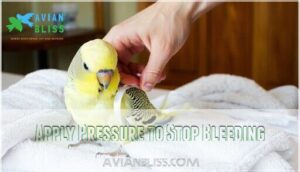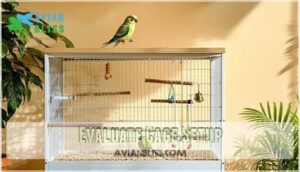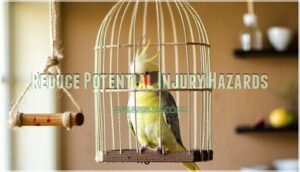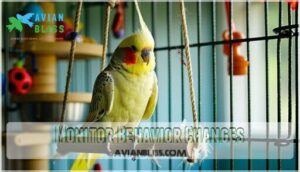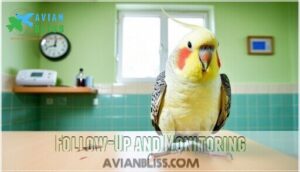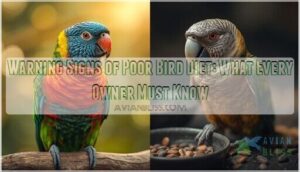This site is supported by our readers. We may earn a commission, at no cost to you, if you purchase through links.
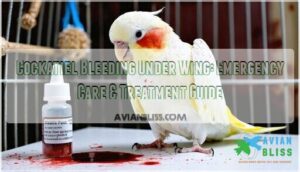
First, identify the source—look for dark, wet blood feathers or visible trauma from cage hazards.
Apply firm pressure with sterile gauze for at least 60 seconds to stop the bleeding.
Use styptic powder sparingly, avoiding the face area.
Keep your bird calm in a quiet environment to prevent shock.
If bleeding persists after initial first aid, seek immediate veterinary care from an avian-experienced professional.
Blood loss can be life-threatening for small birds, so don’t wait and see if it improves on its own.
Understanding the specific techniques for handling different bleeding scenarios could mean the difference between a quick recovery and a tragic outcome.
Table Of Contents
- Key Takeaways
- Identifying The Cause of Bleeding
- Providing Immediate Care
- Seeking Veterinary Assistance
- Ensuring a Safe Environment
- Follow-Up and Monitoring
- Frequently Asked Questions (FAQs)
- Why is my bird bleeding from his wing?
- How do you stop a cockatiel from bleeding?
- Why does cockatiel bleed?
- How to stop cockatiel wing bleeding?
- Can blood feathers heal on their own?
- Why is my bird bleeding under the wing?
- What to do if your cockatiels wing is bleeding?
- Why is my cockatiel bleeding from the bottom?
- Will a blood feather heal on its own?
- Why are my cockatiels feathers growing unusually fast?
- Conclusion
Key Takeaways
- Act quickly to stop bleeding – Apply firm pressure with sterile gauze for at least 60 seconds and use styptic powder sparingly to prevent life-threatening blood loss in your small bird.
- Identify the source immediately – Look for broken blood feathers (dark, wet, crimson quills) or trauma from cage hazards, as these developing feathers contain an active blood supply and will not heal on their own.
- Seek emergency veterinary care – Do not wait to see if bleeding improves; contact an avian-experienced veterinarian immediately if bleeding persists after first aid, as blood loss can be fatal for cockatiels.
- Create a safer environment – Remove sharp edges, secure loose perches, and regularly inspect your cage setup to prevent future wing injuries and bleeding incidents.
Identifying The Cause of Bleeding
When your cockatiel bleeds under its wing, you need to quickly determine what caused the injury to provide proper care.
Look for broken blood feathers, check for signs of trauma like wing collisions, and examine the cage environment for sharp edges or hazards that might’ve caused the bleeding, to ensure you can provide the proper care needed.
Examine for Signs of Trauma
When your cockatiel’s bleeding under its wing, quickly assess for trauma signs that reveal the injury’s severity. Look for visible wing injuries, feather damage, or active blood loss during your initial injury assessment.
Wing Anatomy Survey: Examine wings for cuts, cracks, or abrasions that indicate trauma.
Check Blood Clotting: Assess if bleeding continues or has stopped naturally.
Watch for Infection Signs: Look for redness, swelling, or unusual discharge around wounds.
- Broken blood feathers – Dark red, wet feathers that bleed heavily when damaged
- Wing trauma – Visible cuts or bruising from impacts or falls
- Feather damage – Bent, cracked, or missing feathers indicating recent injury
Check for Blood Feathers
Blood feathers appear as dark red, spike-like growths containing active blood supply during Feather Growth.
These crimson quills are nature’s lifeline—fragile and vital during your bird’s growth phase
During Wing Inspection, look for wet, crimson quills under the wing area.
These developing feathers in Bird Anatomy are fragile and prone to breaking.
A broken blood feather creates substantial bleeding requiring immediate Emergency Response.
Identify these by their distinctive dark coloration and moist appearance compared to mature, hollow feathers, which can help in quick Wing Inspection.
Assess Surrounding Environment
Once you’ve identified potential blood feathers, examine your bird’s cage setup and bird habitat for hazardous objects that could cause wing injury.
Look for sharp edges, loose wires, or dangerous toys that might’ve triggered the cockatiel bleeding under wing. Check if your pet’s been stressed by changes in lighting or environmental hygiene.
A safe environment with proper cage safety measures prevents future incidents while you address the current feather health emergency.
Providing native plants offers seasonal food options for birds.
Providing Immediate Care
When you discover bleeding under your cockatiel’s wing, time becomes critical for preventing dangerous blood loss.
Quick, calm action using basic first aid techniques can stabilize your bird until professional veterinary care becomes available.
Apply Pressure to Stop Bleeding
Once you’ve identified the source of your cockatiel bleeding under wing, immediate gauze application becomes your lifeline. Apply firm, steady pressure using sterile gauze for 1-5 minutes—think of it as giving your feathered friend a gentle hug that stops the flow. Clotting time varies, but don’t peek too early or you’ll restart the process.
Think of your steady hand as your bird’s guardian angel—gentle pressure now prevents panic later.
Your gentle touch is your bird’s lifeline—steady pressure saves precious seconds
If bleeding persists despite your efforts, it’s essential to seek immediate veterinary attention for potential beak injuries.
Follow these pressure duration steps:
- Position gauze directly over bleeding site without restricting breathing
- Maintain steady pressure for minimum 60 seconds before checking
- Monitor for re-bleeding risks by avoiding clot disturbance
- Use powder alternatives like cornstarch if styptic powder isn’t available
Use Styptic Powder
Styptic powder acts like a medical bandage for your feathered friend’s bleeding under wing. Apply sparingly directly to the wound treatment site—too much can irritate delicate skin.
This emergency aid promotes rapid blood clotting within minutes. Keep powder away from your cockatiel’s face to prevent inhalation during bird bleeding treatment.
The effectiveness of Styptic powder products is well-documented, and using the right Styptic powder suppliers can make a significant difference in treatment outcomes.
Prevent Further Trauma
Once you’ve stopped the immediate bleeding, keeping your cockatiel calm becomes your top priority to prevent wing injury recurrence.
Place him in a quiet, secure cage with soft padding and remove any sharp edges that could cause further wing protection issues.
Monitor carefully for signs of renewed bleeding while ensuring proper cage safety measures are in place.
Restrict his movement temporarily to allow proper feather care and healing, preventing additional trauma to the sensitive blood feather area.
Seeking Veterinary Assistance
While you’ve successfully stopped the bleeding, professional evaluation remains critical for your cockatiel’s complete recovery.
An avian veterinarian will determine if underlying issues caused the bleeding and provide appropriate treatment to prevent future episodes, ensuring your cockatiel’s recovery.
Consult Avian-Experienced Veterinarian
When first aid measures aren’t enough to stop the bleeding, you’ll need professional Veterinary Care from Avian Experts who specialize in cockatiel injury cases.
These professionals understand wing bleeding patterns and can provide thorough Emergency Services that go beyond basic cockatiel first aid.
Contact your avian vet immediately—they’re equipped to handle bird emergency care situations and can perform Bird Surgery if needed.
A thorough Vet Consultation guarantees proper diagnosis and prevents complications that could threaten your bird’s life.
Diagnostic Tests for Underlying Issues
Your avian veterinarian will perform thorough diagnostic tests to identify the root cause of your cockatiel’s bleeding. These blood tests, diagnostic imaging, and physical examination help rule out bleeding disorders and underlying health conditions that standard first aid can’t address.
- Blood Work: Complete blood count (CBC) evaluates anemia, infection levels, and clotting function to assess internal bleeding severity
- X-ray Imaging: Radiographs detect fractures, internal injuries, or organ damage that aren’t visible during routine beak inspection
- Feather Analysis: Microscopic examination of damaged blood feathers reveals signs of disease, parasites, or nutritional deficiencies
- Health Screening: Avian veterinary testing includes bacterial cultures and viral panels to identify infectious causes of recurring bleeding episodes
Accurate diagnosis often relies on understanding lab test results to inform treatment decisions.
Treatment Options
After thorough diagnostic testing reveals the root cause, your avian vet will customize treatment based on your cockatiel’s specific needs.
Antibiotics prevent infection while anti-inflammatories reduce swelling and discomfort.
| Treatment Type | Purpose | Timeline |
|---|---|---|
| Pain Management | Comfort during healing | 3-7 days |
| Wound Care | Promote blood clotting | Daily monitoring |
| Feather Repair | Natural regrowth support | 4-6 weeks |
| Emergency Procedures | Styptic powder application | Immediate |
Wing bleeding cases often require behavioral interventions if feather picking triggered the injury.
Ensuring a Safe Environment
After emergency treatment, you’ll need to create a safer environment to prevent future bleeding incidents.
Start by examining your cockatiel’s cage setup and daily surroundings for potential hazards that could cause wing injuries.
Evaluate Cage Setup
Proper cage setup prevents wing accidents before they happen. Make certain your cockatiel has adequate wing space by choosing appropriately sized housing with secure perch height variations.
Cage safety requires removing sharp edges, loose wires, and hazardous toys that threaten feather protection. Maintain cage hygiene with regular cleaning to prevent infections that complicate wing injury treatment.
When selecting a cage, consider the importance of proper cage dimensions to guarantee your cockatiel’s well-being.
Reduce Potential Injury Hazards
Beyond optimizing your cage setup, you’ll need to eliminate specific environmental risks that threaten your bird’s safety.
Remove sharp edges from toys and accessories that could puncture delicate wing anatomy. Replace metal items containing lead or zinc to prevent poisoning during exploratory chewing.
Keep electrical wires covered and secure loose perches that wobble during landings. Position the cage away from windows where bird accidents frequently occur from territorial displays or flight miscalculations.
Monitor Behavior Changes
Beyond cage safety, watching your cockatiel’s behavior reveals early warning signs of cockatiel health issues or stress factors that could lead to bird bleeding episodes.
Changes in social interaction patterns, appetite, or preening habits often signal underlying problems before physical symptoms appear.
- Sleep disruption or lethargy – indicating potential feather injury recovery needs
- Appetite changes – affecting nutrition impact on feather health
- Aggressive or fearful responses – suggesting stress-related cockatiel wing problems
- Excessive preening or plucking – creating risk for new bird accidents
Understanding bird behavior, including bird aggression change, is essential for identifying early signs of stress and anxiety in cockatiels.
Follow-Up and Monitoring
Once bleeding stops, your cockatiel’s recovery requires careful monitoring for the next 24-48 hours to guarantee proper healing.
You’ll need to watch for signs of infection, monitor eating and drinking habits, and schedule follow-up veterinary care to prevent future incidents, ensuring a smooth and healthy recovery.
Healing and Recovery Process
Once your cockatiel’s wing stops bleeding, wound care becomes your priority.
Monitor the injury site daily for signs of infection like swelling or discharge. Blood clotting should form naturally within hours, protecting the damaged area.
Provide nutritional support with vitamin-rich pellets and fresh vegetables to accelerate feather regrowth.
Keep your bird calm in a quiet environment to support post injury healing and the natural feather growth cycle.
Understanding head trauma symptoms is essential for recognizing potential complications and providing proper care.
Regular Health Checks
Schedule cockatiel vet visits every six months with an experienced avian vet for thorough evaluations.
Your regular health checks should include feather inspection, beak checks, nail trimming, and wing examination.
Professional plumage analysis catches problems you might miss.
Between visits, watch for changes in eating habits or behavior patterns that signal trouble brewing.
Preventive Measures
Think of prevention as building an invisible shield around your feathered friend—one that starts with cage safety and smart environmental enrichment.
Focus on nutrition tips that boost immunity while monitoring for early warning signs through consistent health monitoring.
Here are three key preventive measures for bird bleeding prevention:
- Cage Safety & Environmental Setup – Remove sharp objects, secure perches properly, and make certain adequate spacing between cage bars to prevent wing injuries during normal movement.
- Feather Care & Nutrition – Provide balanced pelleted food rich in vitamins A and C, plus regular misting to maintain healthy feather injury prevention and skin condition.
- Health Monitoring & Enrichment – Watch for behavioral changes, offer mental stimulation through toys, and schedule routine avian feather care checkups to catch issues before they escalate into bird safety emergencies.
Frequently Asked Questions (FAQs)
Why is my bird bleeding from his wing?
Your bird’s likely bleeding from a broken blood feather—new, growing feathers with active blood supply.
Trauma, excessive preening, or wing injuries can damage these dark-red quills, causing significant bleeding that requires immediate attention.
How do you stop a cockatiel from bleeding?
Apply gentle pressure with clean gauze, use styptic powder sparingly on the bleeding area, keep your cockatiel calm, and seek immediate veterinary care if bleeding doesn’t stop within minutes.
Why does cockatiel bleed?
Trauma from crashes, wing catches, or excessive preening breaks blood feathers—those dark red growing shafts with active blood supply.
Stress, mites, fights, or accidents damage these vulnerable new feathers, causing significant bleeding.
How to stop cockatiel wing bleeding?
When Tweety’s wing started dripping crimson after hitting the cage door, quick action saved his life.
Immediately apply gentle pressure using clean gauze, then sprinkle styptic powder directly onto the bleeding feather to promote clotting within minutes.
Can blood feathers heal on their own?
Blood feathers can’t heal once broken—they’ll continue bleeding since they contain active blood vessels.
You’ll need to remove the damaged feather or apply pressure with styptic powder to stop bleeding effectively.
Why is my bird bleeding under the wing?
Your bird’s likely bleeding from a broken blood feather – those dark red, developing feathers with active blood supply.
Wing trauma, excessive preening, or accidents can damage these vulnerable new feathers, causing significant bleeding that needs immediate attention, often due to a broken feather.
What to do if your cockatiels wing is bleeding?
Congratulations, you’ve joined the exclusive "panic club" of cockatiel parents!
Immediately apply styptic powder or cornstarch with gentle pressure.
Keep your bird calm, warm, and seek veterinary care if bleeding persists beyond five minutes.
Why is my cockatiel bleeding from the bottom?
Vent bleeding typically indicates broken blood feathers, trauma, or infection. Apply gentle pressure with clean gauze, use styptic powder cautiously, and seek immediate avian veterinary care for proper diagnosis.
Will a blood feather heal on its own?
A damaged blood feather won’t heal on its own – you’ll need to address it promptly.
The broken shaft continues bleeding until properly treated or removed by a veterinarian for your bird’s safety.
Why are my cockatiels feathers growing unusually fast?
Rapid feather growth typically signals stress, hormonal changes, poor nutrition, or underlying health issues.
You’ll want to examine diet quality, environmental stressors, and schedule an avian vet check to identify the root cause promptly, which can help alleviate the underlying issues.
Conclusion
Time truly heals all wounds, but only with proper care and prevention.
When dealing with cockatiel bleeding under wing, your quick response determines the outcome. Remember that blood loss poses serious risks to small birds, making immediate action essential.
After stopping the bleeding and securing veterinary care, focus on creating a safer environment to prevent future incidents.
Regular cage inspections, proper perch placement, and ongoing health monitoring will keep your feathered companion thriving for years ahead.
- https://www.drexotic.com/common-avian-emergencies/
- https://birdsupplies.com/blogs/news/152942023-3-treatment-tips-for-a-bleeding-bird
- https://forums.avianavenue.com/index.php?threads%2Fcockatiel-bleeding-on-wing-shoulders-help-immediately.278997%2F
- https://www.youtube.com/watch?v=qE4dwV4gz54
- https://www.reddit.com/r/cockatiel/comments/1h5ihu5/i_need_help_my_bird_was_bleeding_early_this/

